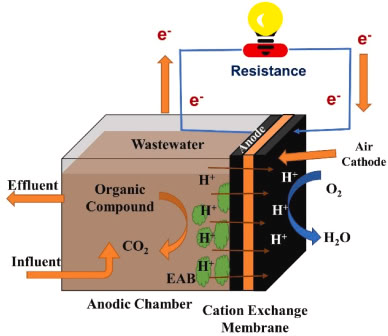 Microbial Fuel Cells (MFCs) are bio-electrochemical devices that convert chemical energy into electrical energy using bacteria as catalysts. Here’s a brief overview:
Microbial Fuel Cells (MFCs) are bio-electrochemical devices that convert chemical energy into electrical energy using bacteria as catalysts. Here’s a brief overview:
Key Points:
- Working Principle:
- Bacteria break down organic matter (substrate)
- During this process, electrons are produced
- These electrons are captured and transferred through an external circuit
- Generates electricity while simultaneously treating waste
- Main Components:
- Anode chamber (where bacteria grow)
- Cathode chamber
- Proton exchange membrane
- External circuit
- Electrodes
- Applications:
- Wastewater treatment
- Biosensors
- Remote power generation
- Sustainable energy production
- Environmental monitoring
- Advantages:
- Environmentally friendly
- Can treat waste while generating power
- Operates at room temperature
- Low maintenance
- Sustainable technology
- Limitations:
- Currently produces relatively low power output
- Scale-up challenges
- Cost of materials
- Limited commercial applications so far
MFCs represent a promising technology that combines renewable energy generation with waste treatment, though they’re still primarily in research and development phases.